

How to Install Smittybilt Gen2 X2O 17,500 lb. Winch on your Wrangler

Shop Parts in this Guide
NOTE: Read entire manual thoroughly before installing and using this product. Keep manual with winch for reference, warranty and future use.
SAFETY PRECAUTIONS
Warning! Observe safety precautions for personal safety and the safety of others. Improper equipment operation may cause personal injury and equipment damage. Read the following carefully before attempting to operate your winch and keep the instructions for future reference.
1. Dress properly:
-Don’t wear loose clothing or jewelry. They can be caught in moving parts.
-Wear leather gloves when handling winch cable. Do not handle cable with bare hands as broken wires can cause injuries.
-Non-skid footwear is recommended
2. Keep a safe distance:
-Ensure that all persons stand well clear of winch cable and load during winch operation, 1.5 times the cable length recommended. If a cable pulls loose or breaks under load, it can lash back and cause serious personal injury or death.
-Don’t step over the cable.
-All visitors and onlookers should be kept away from the work area.
-Keep proper footing and balance at all times.
3. Don’t’ abuse the cord:
-Never carry your winch by the cord or yank it to disconnect it from the receptacle.
-Keep cord from heat, oil and sharp edges.
4. Don’t overwork the winch:
-If the motor becomes uncomfortably hot to touch, stop and let it cool for a few minutes.
-Don’t maintain power to the winch if the motor stalls.
-Don’t exceed maximum line pull ratings shown in tables. Shock loads must not exceed these ratings.
5. Avoid unintentional starting:
-Winch clutch should be disengaged when not in use and fully engaged when in use.
6. Check damaged parts:
-Before using, you should check your winch carefully. Any part that is damaged should be properly repaired or replaced by an authorized service centre.
7. Repair your winch:
-When repairing, use only identical replacement parts or it may cause considerable danger for the user.
8. Re-spool the cable:
-Leather gloves must be worn while re-spooling. To re-spool correctly, it is necessary t keep a slight load on the cable. Hold the cable with one hand and the remote control switch with the other. Start as far back and in the centre as you can. Walk up keeping load on the cable as the winch is powered in.
-Do not allow the cable to slop through your hand and do not approach the winch too closely.
-Turn off the winch and repeat the procedure until all the cable except 1m is in.
-Disconnect the remote control switch and finish spooling in cable by rotating the drum by hand with clutch disengaged.
-On hidden winches, spool in cable under power but keep hands clear.
WINCH OPERATION WARNINGS
Read the following carefully before attempting to operate your winch and keep the instructions for future reference. Smittybilt electric winches are intended for recreational self-recovery usage only.
1. The uneven spooling of cable, while pulling a load, is not a problem, unless there is a cable pile up on one end of the drum. If this happens reverse the winch to relieve the load and move your anchor point further to the centre of the vehicle. After the job is done, you can unspool and rewind for a neat lay of the cable.
2. Store the remote control switch inside your vehicle where it will not become damaged, inspect it before you plug it in.
3. When ready to begin spooling in, plug in remote control switch with clutch disengaged, do not engage clutch with motor running.
4. Never connect the hook back to the cable, this causes cable damage. Always use a sling or chain of suitable strength.
5. Observe your winch while winching, if possible while standing at a safe distance. Stop the winching process every meter or so to assure the cable is not pulling up in one corner. Jamming the cable can break your winch.
6. Do not attach tow hook to winch mounting plate, they must be attached to vehicle frame.
7. The use of a snatch block will aid recovery operations by providing a doubling of the winch capacity and a halving of the winching speed, and the means to maintain a direct line pull to the centre of the rollers. When double loading during stationary winching, the winch hook should be attached to the chassis of the vehicle.
8. Ensure rated “D” or bow shackles are used in conjunction with an approved tree trunk protector to provide a safe anchor point.
9. When extending winch cable, ensure that at least five wraps of cable remain on drum at all times. Failure to do this could result in the cable parting from the drum under load. Serious personal injury or property damage may result.
10. All winches are provided with a red cable marking to identify that 5 cable wraps remain on the winch drum when this mark appears at the rollers. No recovery should be attempted beyond this marking.
11. Since the greatest pulling power is achieved on the innermost layer of your winch, it is desirable to pull off as much line as you can for heavy pulls(you must leave at least 5 wraps minimum on the drum----red cable). If this is not practical use a snatch block and double line arrangement.
12. Draping a heavy blanket or similar object over the extended winch cable is recommended as it will dampen any back lash should a failure occur.
13. Neat, tight spooling avoids cable binding, which is caused when a load is applied and the cable is pinched between the others. If this happens, alternatively power the winch in and out. Do not attempt to work a bound cable under a load, free by hand.
14. Apply blocks to wheels when vehicles are on an incline.
15. Battery:
-Be sure that the battery is in good condition. Avoid contact with battery acid or other
contaminants.
-Always wear eye protection when working around a battery.
-Have the engine running when using the winch, to avoid flattening the battery.
16. Winch cable:
-Be sure that the cable is in good condition and is attached properly.
-Do not use the winch if cable is frayed.
-Do not move the vehicle to pull a load.
-Do not replace the cable with a cable of lesser strength.
-The life of the cable is directly related to the use and care it receives. Following its first and subsequent uses, a cable must be wound on to the drum under a load of at least 500lbs (230kgs) or the outer wraps will draw into the inner wraps and severely damage the cable during winching. The first winch use should be a familiarization run while in a relaxed, non-recovery situation. Spool out the cable until the red cable mark appears(about 5 wraps on the drum),then rewind the cable on the drum under a load of 500lbs(230kgs) or more. This will slightly tension and stretch the new cable and create a tight cable wrap around the drum. Failure to do so may result in cable damage and reduced cable life.
-When the cable is replaced, be sure to apply loctite, or an equal compound, to the cable clamp thread. Tighten the clamp screw properly but do not over tighten. The loctite will prevent loosening of the screw in arduous conditions. Loctite 7471 primer and 222 threadlocker are recommended.
17. Do not attempt to exceed the pulling limits of this winch.
18. Do not drive your vehicle to assist the winch in any way. Vehicle movement in combination with winch operation may overload the cable, the winch itself or cause damaging shock loads.
19. Shock loads when winching are dangerous! A shock load occurs when an increase force is suddenly applied to the cable. A vehicle rolling back on a slack cable may induce a damaging shock load.
20. The winches shown in this manual are solely for vehicle and boat mounted, nonindustrial applications.
21. Do not use winch in hoisting applications due to required hoist safety factors and features.
22. Do not use the winch to lift, support or otherwise transport personnel.
INSTALLATION
Mounting your winch
1. The winch is to be mounted into a suitable steel mounting frame using the 4 point foot mounting system in either a horizontal or vertical plane. It’s very important that the winch be mounted on a flat surface so that the three sections (motor, cable drum and gear housing) are properly aligned. --The fitment of winches and / or a frontal protection system may affect the triggering of SRS air bags. Check that the mounting system has been tested and approved for winch fitment in the airbag equipped vehicle.
2. Winch mounting frames and / or frontal protection systems are suggested to suit most popular vehicles. Winch frames are packaged with detailed fitting instructions.
3. Should you wish to manufacture your own mounting plate the dimensions below will assist. A steel mount plate 6mm thick is recommended. Fasteners should be steel high tensile grade 5 or better. A poorly designed mount may void warranty.
4. The winch should be secured to the mounting with 3/8” UNC x 1-1/4” stainless steel bolts and spring washers provided.
5. The roller fairlead is to be mounted so as to guide the rope onto the drum evenly.

Lubrication installation
All moving parts in the winch are permanently lubricated with high temperature lithium grease at the time of assembly. Lubricate cable periodically using light penetrating oil. Inspect for broken strands and replace if necessary. If the cable becomes worn or damaged it must be replaced.
Cable installation
Unwind the new cable by rolling it along the ground, to prevent kinking. Remove old cable and observe the manner in which it is attached to the cable drum flange.
Electrical Connection (8000 ,10000,12000,)
For normal self-recovery work, your existing electrical system is adequate. A fully charged battery and proper connections are essential. Run the vehicle engine during winching operations to keep battery charged.
Pay close attention to proper electrical cable connection as follows (Refer to diagram 1)
1. Short red cable (B’) connecting to the red terminal (B) of the motor.
2. Short black cable with yellow jacket (C’) connecting to the yellow terminal(C) of the motor.
3. Short black cable with black jacket (D’) connecting to the black terminal (D) of the motor. The thin black cable (a’) connecting to bottom terminal (A) of the motor
4. Long black cable (1.8m), one terminal (A’) connecting to the bottom terminal (A) of the motor, and the other terminal negative (-) connecting to negative (-) terminal of battery.
5. Long red cable positive ( ) connecting to positive ( ) terminal of battery.
Electrical connection (15,000)
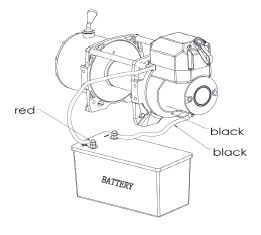
1. Long black cable (1.8m), one terminal (A’) connecting to the bottom terminal (A) of the motor, and the other terminal negative (-) connecting to negative (-) terminal of battery.
2. Long red cable positive ( ) connecting to positive ( ) terminal of battery.
WIRING ATTENTION
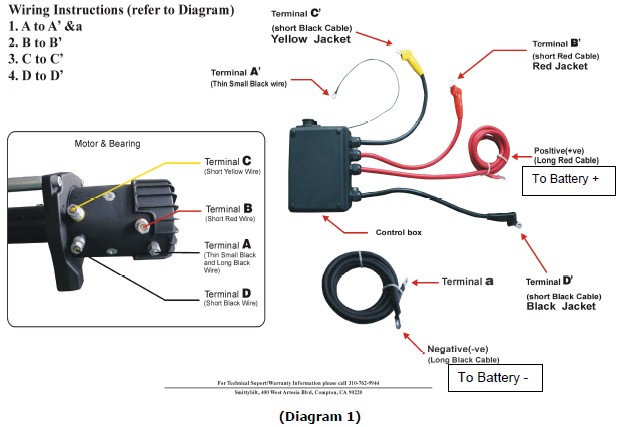
Note:
1. Your battery must be kept in good condition.
2. Be sure battery cables are not drawn taught across any surfaces, which could possibly damage them.
3. Corrosion on electrical connections will reduce performance or may cause a short.
4. Clean all connections especially in remote control switch and receptacle.
5. In salty environments use a silicone sealer to protect from corrosion.
6. Index the heads of the plate studs into the keyhole slots on the back of the winch.
7. Attach the winch/Adaptor plate assembly to your trailer hitch, by inserting the trailer hitch ball through the shaped hole in the adaptor plate.
Installing the control box
> It is recommended to install you winch control box prior to installing your winch.
> You may install the control box in a separate location using 3-4 AWG marine cable (not included)
> Determine if you want your control box located over the motor (side) or the drum (Center)
DRUM (Center Mount)
Step 1: Install the two included zinc brackets on the bottom of the control box by removing the four nuts on the bottom of the box, then placing the brackets over the bolts and then secure brackets by re-installing the nut. (Fig A) (Note: The hooks on the brackets go towards the front of the winch.) Use caution when installing brackets in order not to push the bolts up into the control box. To help prevent this, install brackets with the control box on its side instead of laying it flat on a table.
Step 2: Secure the brackets to the winch by placing the front hooks on the brackets around the front tie-rod then push the rear down over the rear tie-rods. Secure by tightening the the screw on the rear of each bracket (Fig B)
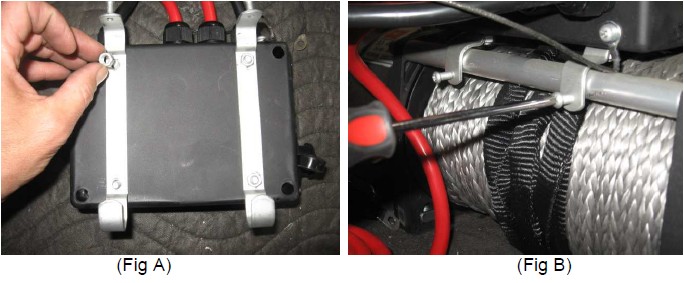
MOTOR (Side Mount)
Step 1: Install the two black motor mount brackets on the bottom of the control box by removing the four nuts on the bottom of the box, then placing the brackets over the bolts and then secure brackets by re-installing the nut. Note: The end of the brackets point outward. (Fig D) Use caution when installing brackets in order not to push the bolts up into the control box. To help prevent this, install brackets with the control box on its side instead of laying it flat on a table.
Step 2: Install the control box by lining it up with the two holes on the motor side upright, then Secure with the included hardware. (Fig E, F)

Remote Control
> Do not force end of remote plug into the plug on the control box.
> Line the tab on the inside of the remote socket end with the groove on the remote plug on the control box. (Fig G,H)
> Push the toggle switch upward to operate the winch “Outward” .Note: You should always “Free Spool” the winch outward.
> Push the toggle switch downward to operate the winch “Inward”
> The remote features a magnet on the front which enables you to keep the remote off of the ground by having it placed on your vehicle, bumper, ect. (Fig I)

Winch Operation
The best way to get acquainted with how your winch operates is to make a few test runs before you actually need to use it. Plan your test in advance. Remember you can hear your winch as well as you can see it operate. Get to recognize the sound of a light steady pull, a heavy pull, and sounds caused by load jerking or shifting. Soon you will gain confidence in operating your winch and its use will become second nature to you.
Operating
1. Ensure the vehicle is secure by applying the parking brake or chocking the wheels.
2. Pull out the winch cable the desired length and connect to an anchor point. The winch clutch allows rapid uncoiling of the cable for hooking onto the load or anchor point. The shifter tab located on the gear housing of the winch operates the clutch as follows: a) To disengage the clutch, move the clutch shifter tab into the “OUT” position. Cable may not be free spooled off the drum. b) To engage the clutch, move the clutch shifter tab into the “IN” position. The winch is now ready for pulling.
3. Recheck all cable rigging before proceeding.
4. Plug in the winch hand control. It is recommended that the winching operation takes place from the driver’s position to ensure safe operation.
5. To commence winching operation, start vehicle engine, select neutral in transmission, maintain engine speed at idle.
6. Operated the remote control switch to IN or OUT until the vehicle has been retrieved. Regularly check the winch to ensure cable is winding onto the drum evenly.
MAINTENANCE
It is highly recommended that the winch be used regularly (once a month). Simply power the cable out 15m, free spool 5m and then power back in. this will keep all components in good working condition so that the winch can be relied on when needed. Contact your authorized outlet for technical assistance and repairs.
1. Never winch with your vehicle in gear or in part, which would damage your vehicle’s transmission.
2. Never wrap the cable around the object and hook onto the cable itself. This can cause damage to the object being pulled, and kink or fray the cable
3. Keep hands, clothing, hair and jewellery clear of the drum area and cable when winching.
4. Never use the winch if the cable is frayed, kinked or damaged.
5. Never allow anyone to stand near the cable or in line with the cable behind the winch while it is under power. If the cable should slip or brake, it can suddenly whip back towards the winch, causing a hazard for anyone in the area. Always stand well to the side while winding
6. Don’t leave the switch plugged in when is not in use.
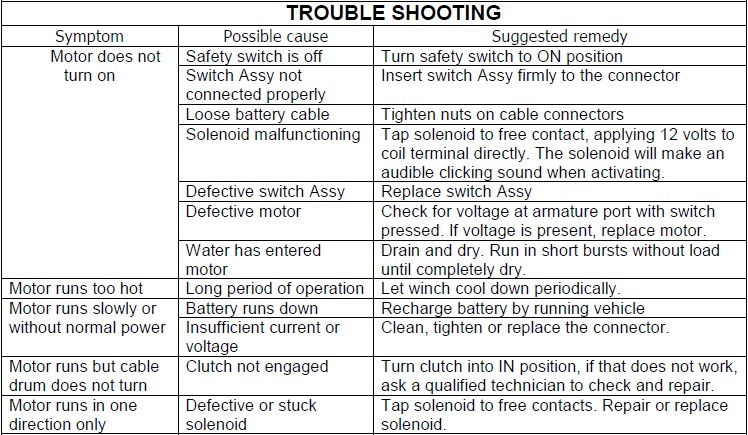
Understanding IP Ratings
> The first digit indicates the level of protection that the enclosure provides against access to hazardous parts (e.g., electrical conductors, moving parts) and the ingress of solid foreign objects.
> The second digit indicates protection of the equipment inside the enclosure against harmful ingress of water.
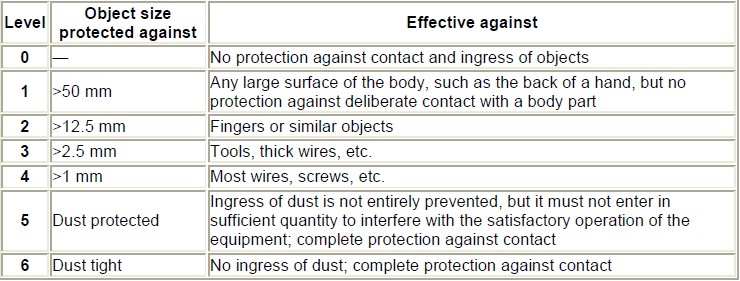
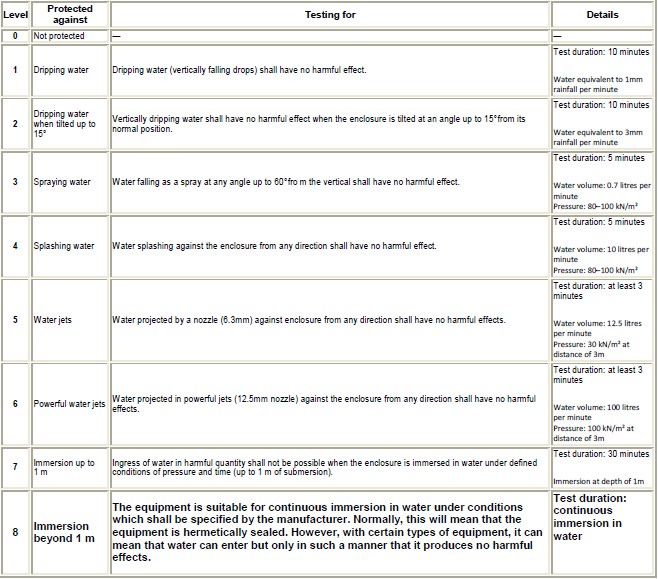
Gear Housing “Clocking”
In some situations you may need to “Clock” (turn) your Gear Housing in order to gain access to them.
Step 1: Loosen and remove the two tie rod bolts on the gear box side.
To clock the Gear Box
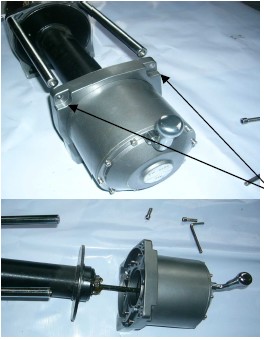
Step 2: Remove the small retaining bolts on the inside of the gear box
Step 3: Rotate the gear box to the optimal position needed. Then re-install the retaining bolts and re connect gear box to the tie-rod bars.
Note: “Clocking” must be done in 36 degree intervals due to the position of the retaining bolt holes.
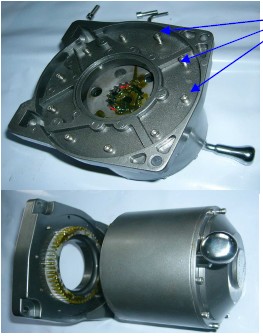
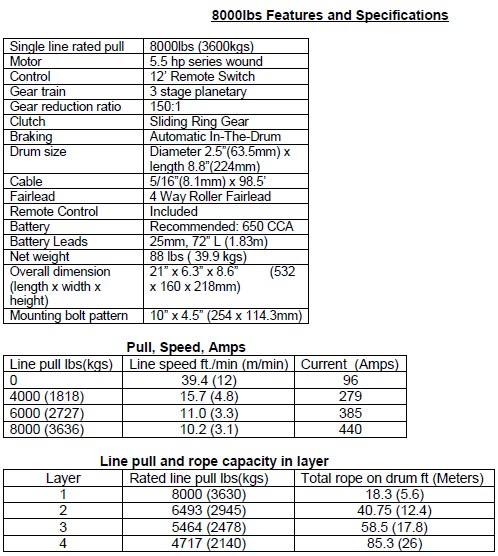
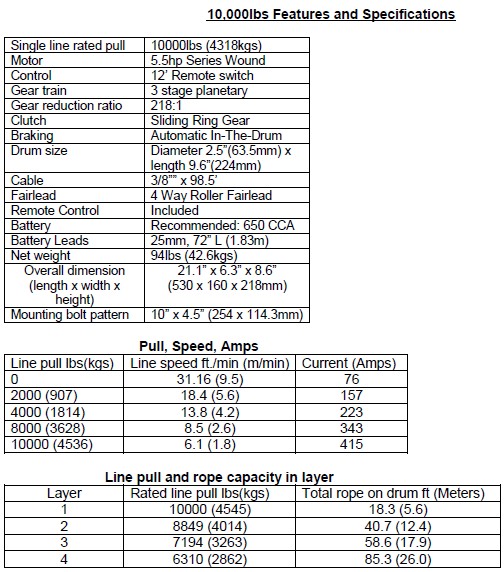
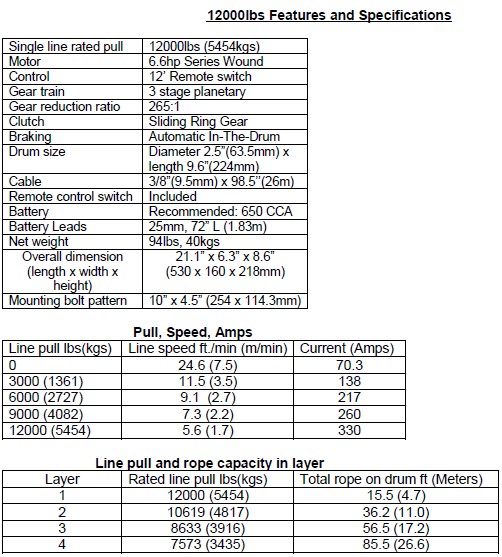
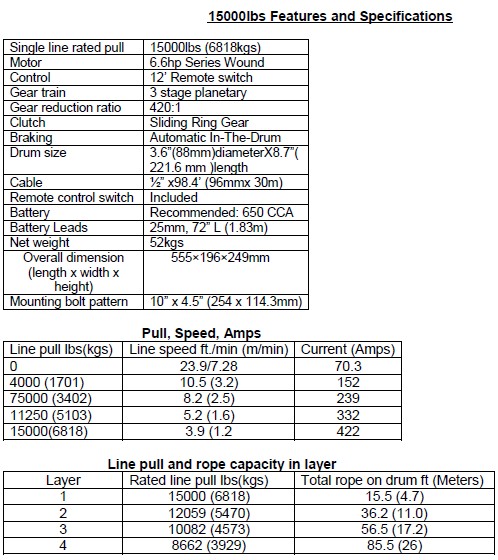
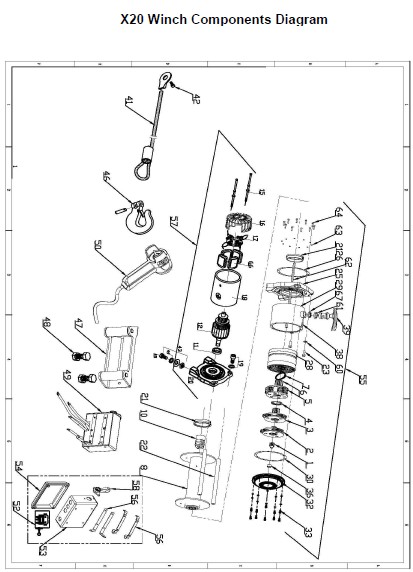
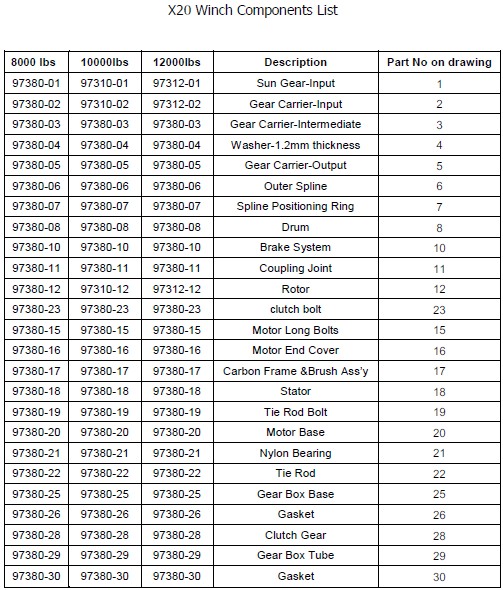
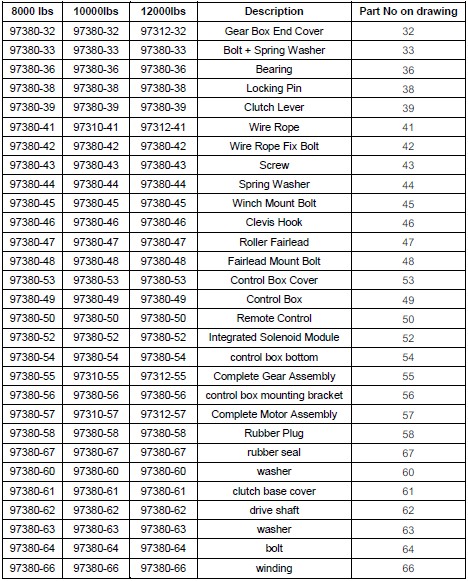
Compliment your new Winch with a Smittybilt Winch Cover or other Smittybilt products
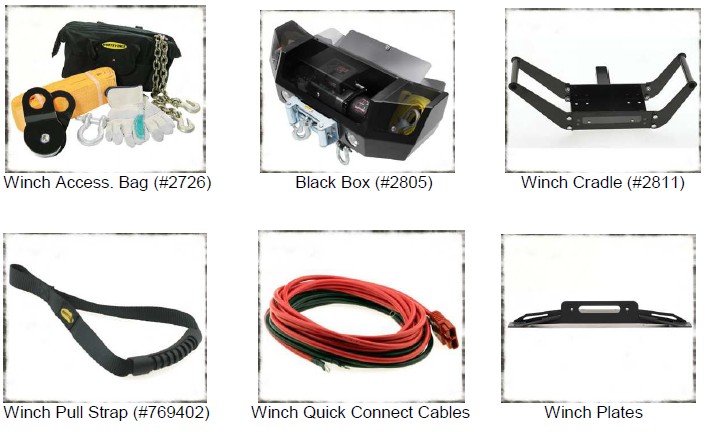
Warning
Rollover and other types of vehicle accidents may result in serious injury or death to you, your passengers and others sharing the road. Smittybilt accessories are decorative and are not intended to reduce or avoid injury or damage in the event of an accident. The weight and location of Smittybilt accessories may affect your vehicles’ handling, stability and performance, creating an increased risk of accident or rollover. Before installing any accessory, check state laws and assure that the accessory will not obscure any lights or interfere with proper operation on your vehicle’s safety equipment. Consult your owner’s manual and the Smittybilt instructions, or additional safety information. Smittybilt products, nor the warnings contained herein, are not a substitute for your safe driving. Don’t drink and drive, always use seat belts and don’t drive faster than conditions permit.
